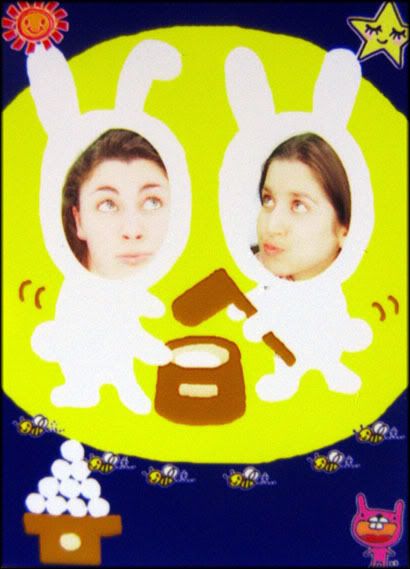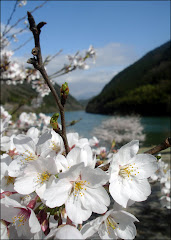
Incredible image courtesy of Flickr's
Tumpaksinen. It's visual haiku!
After a seemingly endless summer of humid heat and hazy skies, the first full moon to grace a cool, clear, autumn night can be a magnificent sight, especially in the right surroundings.
Otsukimi, or "Honorable Moon-Viewing", has been celebrated in Japan since the beginning of the 10th century.
Long ago, the people of ancient Japan had a deep, emotional attachment to the ever-changing moon, a mystical heavenly body that measured their lives in times and seasons. The full moon was considered the most beautiful of all, and the most beautiful of all full moons was mid-Autumn's
Chushu no Meigetsu, the Harvest moon, traditionally rising on the 15th evening of the 8th month (according to Japan's old lunar calendar).

The custom of holding banquets to admire the moon became common during Japan's Golden Era, the Heian Period (794-1192). Imperial aristocrats
enjoyed elegant, moon-lit parties called
Mizuki and
Tsuki-no-utage, composing w
aka (31-syllable Japanese poems), listening to noble court music, and drinking sacred
sake aboard leisure boats from which they watched the moon’s reflection in the moving water.
Marked with decorations of Japanese pampas grass and offerings of rice dumplings, taro, chestnuts, soybeans, and
sake, today’s moon viewing parties are held to enjoy good times with friends and family. In the past, farmers made offerings of pampas grass and bush clover to the full moon to ensure a good harvest. Now a small arrangement of
susuki, hagi (pampas grass and bush clover), and the seven fall flowers are offered in hopes that wishes will come true.
Uh-oh, She's Reminiscing, Ya'll...
Even without the help of these autumn talismans, many a wish can come true beneath a Harvest Moon. During my first year as a JET, I sat alone on the dry bank of a freshly harvested rice field in Higashino, where my evening walks often led me through narrow streets spotted with traditional houses, surrounded on all sides by rice fields, silhoutted foothills and far-off mountains. I admired the moon, recalling, as I often did during my experience in Japan, one of my favorite Thoreau quotes: "Our truest life is when we are in dreams awake". I tried to drink it all in, fully aware that my time in Japan would be beautiful but breif, yet sure that it would be with me forever.
In my second year, I watched Autumn's first full moon rise over Cambodia's Tonle Sap, only to see it melt away the next morning as the sun rose over Angkor Wat.
Ironically, I was so busy planning lessons during my last Otsukimi in Japan that I barely had a chance to enjoy it, something that speaks volumes about my final year there. I remember catching sight of it as I drove home from the grocery store, wishing for the time and peace of mind to truely enjoy it as I once had.
Thankfully, I was granted both this year as I watched the moon grow gradually from a sliver of silver in the obsidian sky to a hauntingly pale, celestial apparition shrouded in veils of cloud and night. It finally revealed itself during a moon-lit roadtrip from Nebraska to Minnesota, bobbing bashfully along the shadowy ridges of birch, maple, and pine before sailing out to open skies. Reflected in 10,000 lakes, close enough to the horizon to seem colossal, it's etheral impermanence filled the night with a lonely beauty too perfect for words.

Somewhere over Minnesota, September 27th, 2007
It was a great night. It's good to be back.
 As Cultural Ambassadors, Abbey and I felt it our duty- nay, our privilege- to spread what little Halloween cheer we might by sporting festive 100 yen headbands, not only for our holiday puri session, but to sushi as well, spreading "knowledge and awareness" to all.
As Cultural Ambassadors, Abbey and I felt it our duty- nay, our privilege- to spread what little Halloween cheer we might by sporting festive 100 yen headbands, not only for our holiday puri session, but to sushi as well, spreading "knowledge and awareness" to all.




 "Moon Rabbit" mochi
"Moon Rabbit" mochi Sugary tsukimi wagashi, Japanese sweets shaped as bunnies, tsukimi dango moon-viewing rice dumplings), chestnuts, mushrooms, fall flowers and of course, the full moon veiled in pampass grass.
Sugary tsukimi wagashi, Japanese sweets shaped as bunnies, tsukimi dango moon-viewing rice dumplings), chestnuts, mushrooms, fall flowers and of course, the full moon veiled in pampass grass.


 Somewhere over Minnesota, September 27th, 2007
Somewhere over Minnesota, September 27th, 2007

